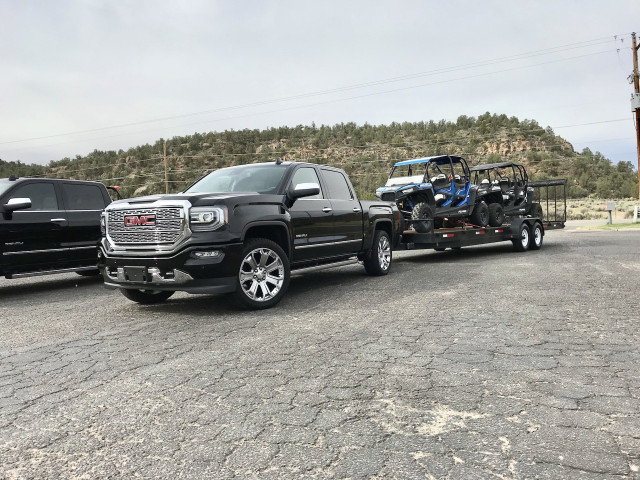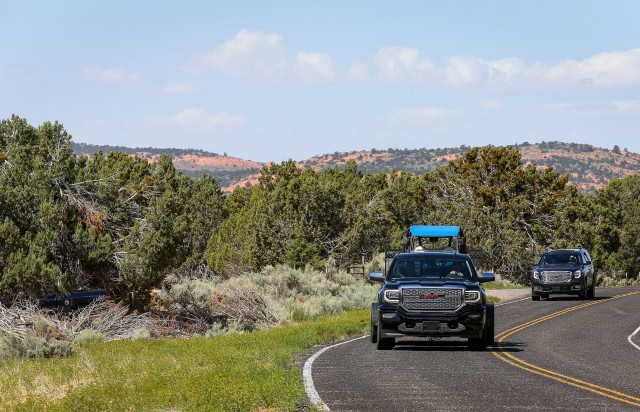Boats, jet skis, and ATVs: these fun machines won’t get to the lake or the trail on their own.
How do they get there? Behind another vehicle, usually a pickup truck. Research has shown that three-quarters of all light-duty pickup owners actually put their trucks to work towing things. Of those, nearly a third tow more than just once a month. But it’s also true that many light-duty truck owners don’t know how much their trucks can safely tow.
Perhaps it’s time for a quick refresher on the basics of towing before it’s time to pack up the family, hitch up the weekend toys, and load up for some fun. Here are the basics.


2018 GMC Sierra 1500 Denali
Understand your trailer
Not all trailers are built equally. There are five different classifications of trailers ranging from light duty all the way to maximum heavy duty. The differences include the weight each is rated to carry, type of hitch it should be hooked to, tongue weight, and construction including number of axles and materials. Start by knowing what will be hauled and then determine the appropriate trailer for the load.


2018 GMC Sierra 1500 Denali
Use the right hitch
Different vehicles and trailers require unique hitches. It’s important that the hitch keeps the trailer level and fits snugly in the vehicle’s receiver. For instance, some vehicles with big 22-inch wheels may require a drop hitch to keep the trailer load level once hooked up, due to the receiver height.


2018 GMC Sierra 1500 Denali
How much does that weigh?
It’s essential to know what everything weighs, including the trailer, cargo being hauled, tow vehicle, and even the passengers, pets, and cargo inside the vehicle. It all adds up and needs to be under the gross combined weight rating of the tow vehicle. Miscalculating or not knowing the weight of the entire setup can put everyone involved and on the road in harm’s way.


2018 GMC Sierra 1500 Denali
Balance is everything
It’s imperative that the load being towed is balanced with weight evenly distributed to ensure control of the vehicle and trailer. The tongue weight—the downward force the trailer tongue exerts on the vehicle’s hitch—should be approximately 10 to 15 percent of the loaded trailer total weight. Confirming this will help improve stability and reduce the chance of trailer sway while rolling down the road.


2018 GMC Sierra 1500 Denali
Check all the things
Before towing, it’s important to note that all the trailer lights are operating––brake lights, turn signals, and running lights—the trailer safety chains are properly crossed and connected, and that the trailer tires are at the recommend pressure. Each time the vehicle stops for gas or a rest break it’s a smart idea to check that all connections are still intact, everything’s still properly hooked up, and the load hasn’t shifted.


2018 GMC Sierra 1500 Denali
Speed limited
Just because a vehicle can haul a trailer down the road at 85 mph doesn’t make it safe or a good idea. Many trailer tires aren’t rated for high speeds. Ignoring this could result in a tire blow out, or worse, a crash. Note whether the trailer being hauled has a speed rating and adhere to the recommend maximum.


2019 Dodge Durango SRT towing
Embrace technology
Towing isn’t easy, but advances in technology have made it safer and more enjoyable. Many trucks have built-in trailer brake controllers from the factory. Gone are the days of having to install a clunky, ugly, aftermarket brake controller to a vehicle’s dashboard. Rearview cameras have made backing up to connect a trailer easier, and electronic trailer sway control helps keep the trailer going straight behind the vehicle by utilizing yaw sensors and the braking system to bring a trailer back into control. Some trucks even have blind-spot monitors that know to include the trailer behind the truck.


2018 GMC Sierra 1500 Denali
Physics: Science is cool
When towing vehicle dynamics change dramatically. It takes longer to stop, there’s weight that’s lashed behind the vehicle that’s pulling and pushing, and vehicle systems such as the engine, brakes, transmission, and tires are all working harder than normal. A change in driving style is required including but not limited to leaving extra space between your vehicle and the vehicle in front of you, planning extra time and space for acceleration and braking, and keeping both hands on the steering wheel with smooth inputs to steering, gas, and brakes.
